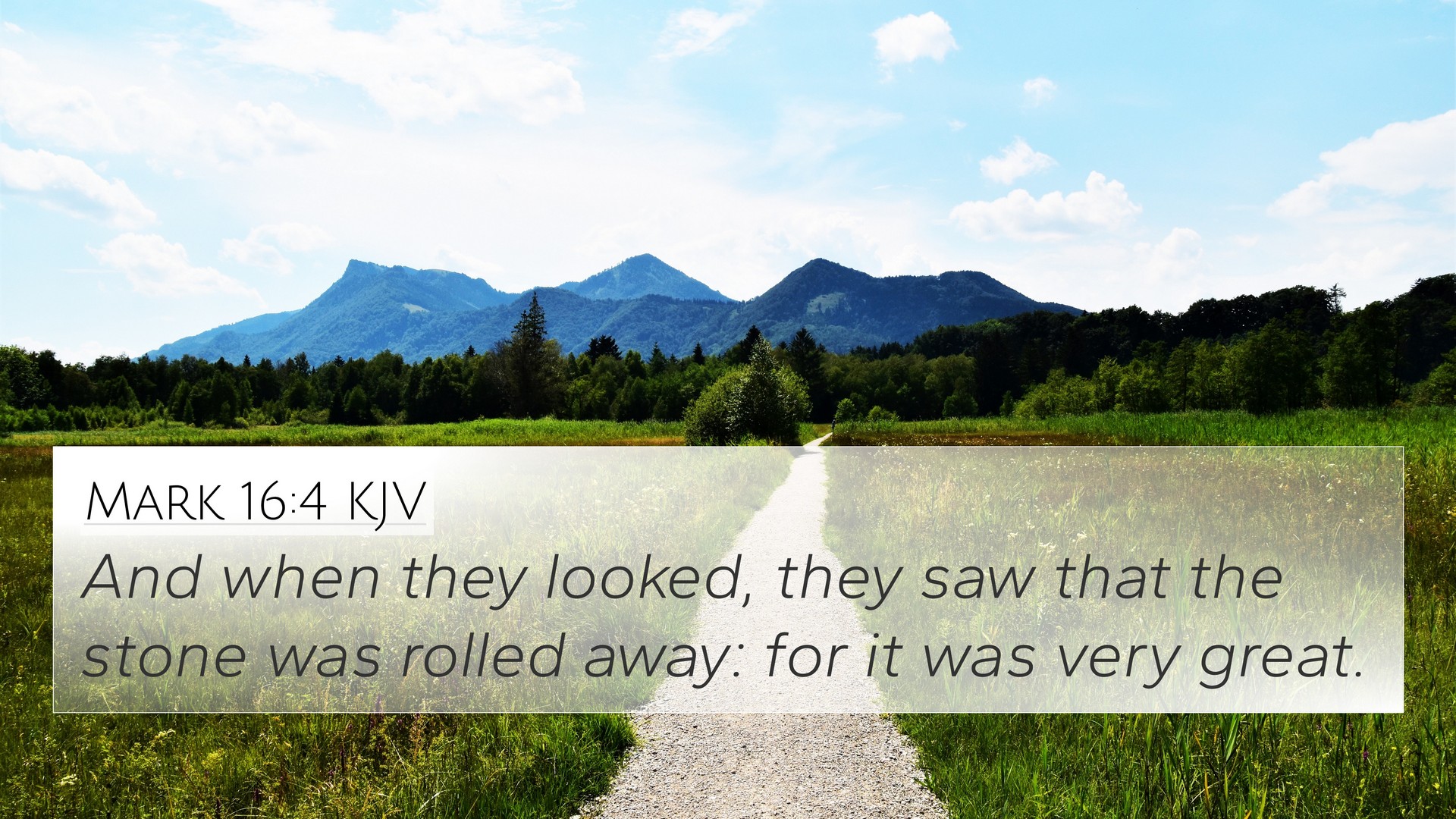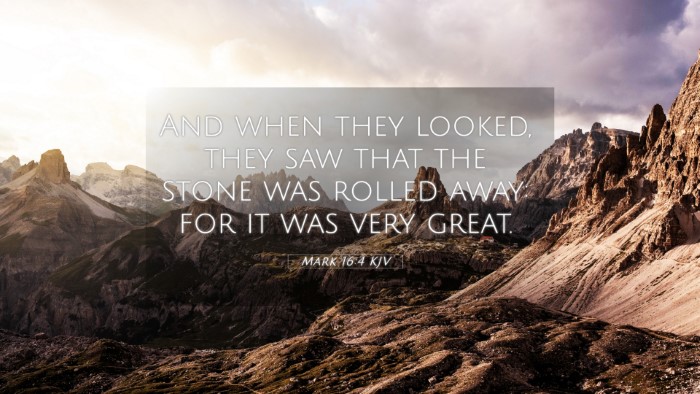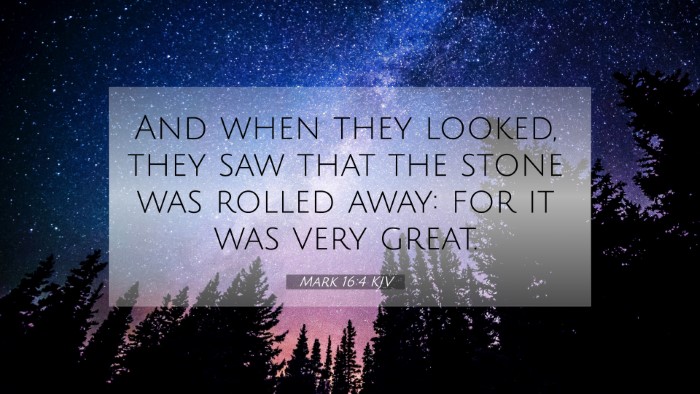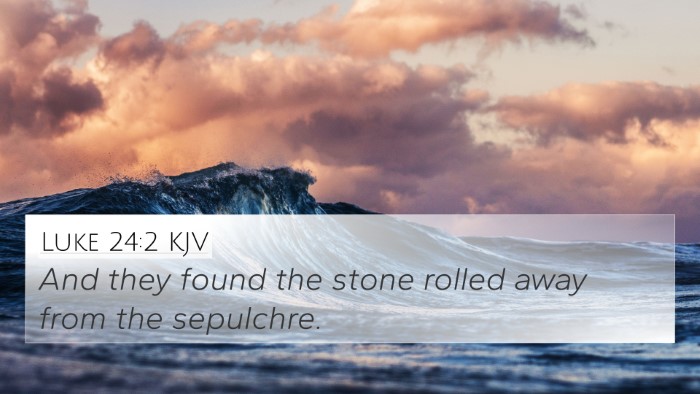Old Testament
Genesis Exodus Leviticus Numbers Deuteronomy Joshua Judges Ruth 1 Samuel 2 Samuel 1 Kings 2 Kings 1 Chronicles 2 Chronicles Ezra Nehemiah Esther Job Psalms Proverbs Ecclesiastes Song of Solomon Isaiah Jeremiah Lamentations Ezekiel Daniel Hosea Joel Amos Obadiah Jonah Micah Nahum Habakkuk Zephaniah Haggai Zechariah MalachiMark 16:4 Similar Verses
Mark 16:4 Cross References
And when they looked, they saw that the stone was rolled away: for it was very great.
Uncover the Rich Themes and Topics of This Bible Verse
Listed below are the Bible themes associated with Mark 16:4. We invite you to explore each theme to gain deeper insights into the Scriptures.
Mark 16:4 Cross Reference Verses
This section features a detailed cross-reference designed to enrich your understanding of the Scriptures. Below, you will find carefully selected verses that echo the themes and teachings related to Mark 16:4 KJV. Click on any image to explore detailed analyses of related Bible verses and uncover deeper theological insights.
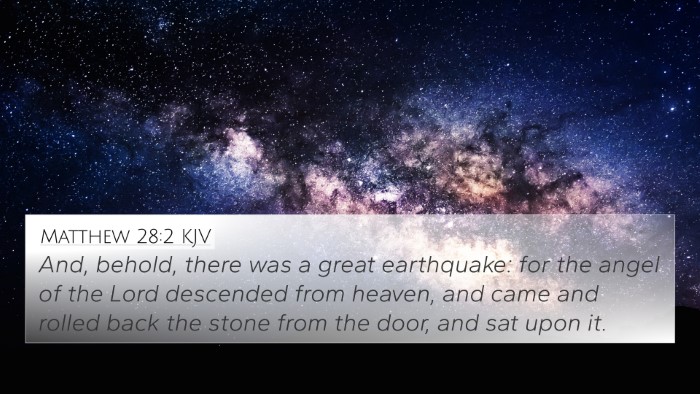
Matthew 28:2 (KJV) »
And, behold, there was a great earthquake: for the angel of the Lord descended from heaven, and came and rolled back the stone from the door, and sat upon it.
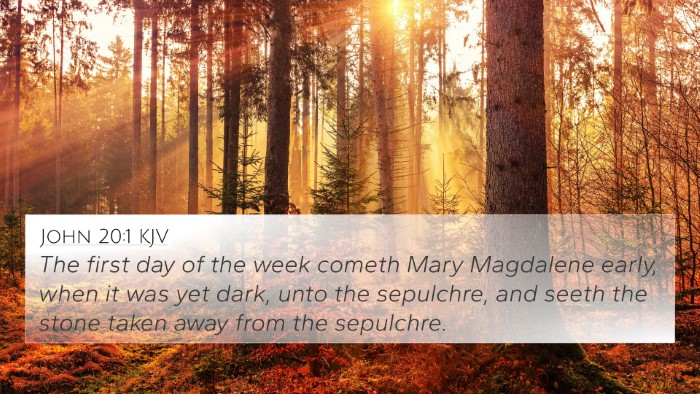
John 20:1 (KJV) »
The first day of the week cometh Mary Magdalene early, when it was yet dark, unto the sepulchre, and seeth the stone taken away from the sepulchre.
Mark 16:4 Verse Analysis and Similar Verses
Bible Verse Meaning of Mark 16:4
Mark 16:4 states: "And when they looked, they saw that the stone was rolled away; for it was very great." This verse occurs during the Easter morning account when Mary Magdalene and other women go to the tomb of Jesus. The verse emphasizes the miraculous event of the stone being rolled away, signifying a pivotal moment in Christian faith—the resurrection of Jesus Christ.
Interpretation and Insights
This verse has been studied extensively, revealing several significant insights:
- Significance of the Stone: The great stone at the tomb represents the finality of death, but its removal signifies victory over death and the hope of resurrection.
- Divine Intervention: The act of the stone being rolled away is perceived as a divine action, demonstrating God's power in raising Jesus from the dead.
- Empowerment of the Faithful: The women’s journey to the tomb symbolizes the dedication and faithfulness of Christ's followers, highlighting their role in the resurrection story.
- Connection to Prophecy: This verse is often connected to Old Testament prophecies concerning resurrection and redemption, reinforcing the continuity of Scripture.
Cross-References
Mark 16:4 relates to several other Bible verses that help to deepen its meaning:
- Matthew 28:2: "And behold, there was a great earthquake; for an angel of the Lord descended from heaven and came and rolled back the stone and sat on it." This parallels the miraculous removal of the stone and emphasizes divine involvement.
- Luke 24:2: "And they found the stone rolled away from the tomb." This reinforces the historical account presented in Mark.
- John 20:1: "Early on the first day of the week, while it was still dark, Mary Magdalene went to the tomb and saw that the stone had been removed from the entrance." This establishes another witness to the event.
- Isaiah 53:10-11: These verses point to the suffering servant and the ultimate purpose of Jesus’ sacrifice, linking to the importance of His resurrection.
- Romans 6:4: "We were therefore buried with him through baptism into death in order that, just as Christ was raised from the dead through the glory of the Father, we too may live a new life." This passage acknowledges the implications of the resurrection for believers.
- Acts 2:24: "But God raised him from the dead, freeing him from the agony of death, because it was impossible for death to keep its hold on him." This explicitly confirms the act of resurrection as essential to Christian doctrine.
- Revelation 1:18: "I am the Living One; I was dead, and now look, I am alive for ever and ever!" This verse portrays the lasting significance and power of Christ’s resurrection.
- 1 Corinthians 15:55: "Where, O death, is your victory? Where, O death, is your sting?" This celebrates the victory over death that the resurrection represents.
Thematic Connections
Through engaging with such connections, we explore:
- The Power of God: Mark 16:4, when linked with the other accounts of resurrection, highlights God's omnipotence—uplifting believers through the assurance of victory over death.
- Faith and Expectation: The women’s expectation of finding Jesus dead meets the reality of His resurrection, prompting reflections on faith amidst circumstances.
- Historical Narrative: Mark 16:4 serves as a crucial narrative link between the Gospel accounts, enhancing our understanding of the resurrection event in a cohesive Gospel framework.
Application for Believers
The resurrection signifies hope, renewal, and new beginnings. As believers reflect on Mark 16:4, they are encouraged to:
- Trust in God’s Power: Recognize that God can roll away the stones in their lives—be they challenges, fears, or doubts.
- Embrace Faith: Cultivate a deeper faith that anticipates divine action, just as the women did on that momentous morning.
- Share the Good News: Like the women who went to the tomb, Christians are called to share the message of hope and resurrection with others.
Conclusion
Mark 16:4 not only narrates a historical event but serves as a transformative message for believers today. The act of the stone being rolled away encapsulates the triumph of life over death—an essential theme across the Bible. In sum, exploring cross-references enhances understanding of this pivotal moment and encourages deeper faith in the resurrection's implications.
